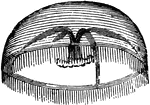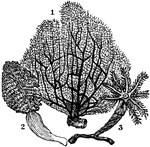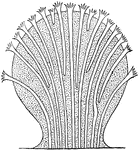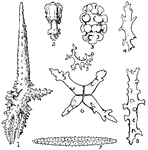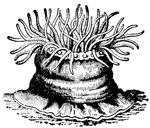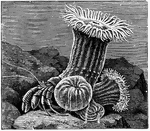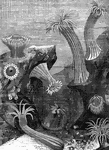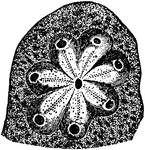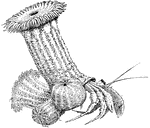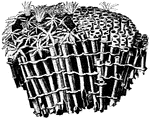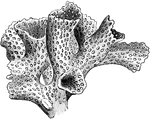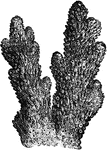The Corals and Sea Anemone ClipArt gallery provides 241 images of corals and sea anemone in the phylum cnidaria. They attach themselves to the bottom using an adhesive 'foot', called a basal disc.

Actinian
"A, diagram showing the sequence of mesenterial development in an Actinian. B, diagrammatic transverse…
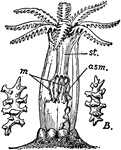
Alcyonarian
"An expanded Alcyonarian zooid, showing the mouth surrounded by eight pinnate tentacles. st, Stomodaeum…
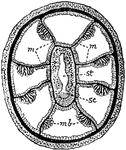
Alcyonarian
"Transverse section of an Alcyonarian zooid. mm, Mesenteries; mb, muscle banners; sc, sulcus; st, stomodaeum."…
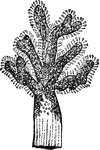
Alcyonium
"A genus of Zoophytes, the type of family called Alcyonide, belonging to the class anthozoa, and order…

Alcyonium
"A genus of Zoophytes, the type of family called Alcyonide, belonging to the class anthozoa, and order…

Alcyonium Digitatum
"A genus of Zoophytes, the type of family called Alcyonide, belonging to the class anthozoa, and order…
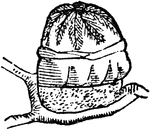
Alcyonium Digitatum
"A genus of Zoophytes, the type of family called Alcyonide, belonging to the class anthozoa, and order…
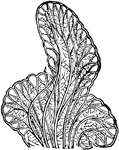
Alcyonium Digitatum
"A genus of Zoophytes, the type of family called Alcyonide, belonging to the class anthozoa, and order…
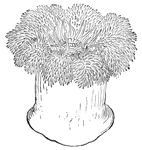
Anemone
The tentacles of the sea anemone are numerous and are borne on a disk surrounding the mouth at the free…
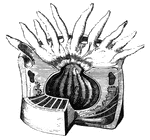
Sea Anemone
The stomach and mouth of a Sea Anemone. c - tentacles; d - mouth; e - stomach; g,g' - openings in the…

Sea Anemone
"Vertical section of a sea anemone. t., Tentacles; o., mouth; oes., oesophagus; c., c'., apertures through…
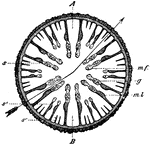
Sea Anemone
"Section through sea anemone. A, B, Directive septa; m.f., mesenteric filaments; g., genital organs;…

Sea Anemones
The popular name given to a number of animals of the subkingdom Coelenterata and class Actinozoa, including…
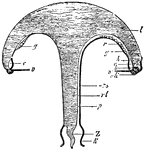
Anthomedusae
"Medusiform person, one of the Anthomedusae, detached from a hydroid colony of Syncoryne. Ocelli are…
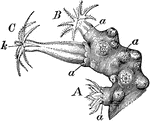
Anthozooids
"End of a branch of red coral of commerce, Corallium rubrum, with three anthozooids, A, B, C, in different…
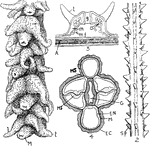
Antipatharians
"Structure of Antipatharians. 1. A group of polyps--M. mouth; t., tentacles. 2. Axis without polyps…
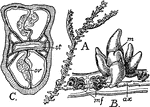
Antipathes Dichotoma
"A, portion of a colony of Antipathes dichotoma. B, single zooid and axis of the same magnified. m,…
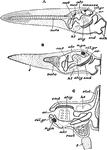
Ascidian Stages
"Diagram of the metamorphosis of the free, tailed larva into the fixed Ascidian. A, stage of free-swimming…
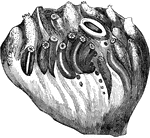
Compound ascidians
"The compound ascidians, or Botryllidae, are united togetyher by the coalescence of of their…
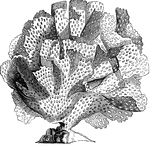
Compound Ascidians
"The compound ascidians, or Botryllidae, are united togetyher by the coalescence of of their…

Social Ascidians
"The Clavellinidae, or Social Ascidians, are united by means of a sort of creeping…

Astroides Calicularis
"Tangential section of a larva of Astroides calicularis which has fixed itself on a piece of cork. ec,…

Astylus Subvividis
"Portion of the corallum of Astylus subvividis (one of the Stylasteridae), showing cyclosystems placed…
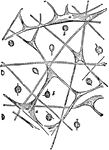
Aurelia
"Gelatinous substance of the disc of Aurelia, showing-a, fibrous trabeculae, and b, wandering endoderm…
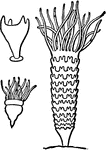
Aurelia
"Development of Aurelia. Above to the left, young scyphistoma with four perradial tentacles. Below to…
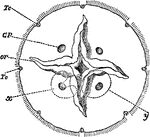
Aurelia Aurita
"Surface view of the sub-umbrella or oral aspect of Aurelia aurita, to show the position of the openings…

Aurelia Aurita
"Half of the lower surface of Aurelia aurita. The transparent tissues allow the enteric cavities and…

Aurelia Aurita
"Tentaculocyst and marginal lappets of Aurelia aurita. In the lefthand figure-ML, marginal lappets;…

Blue Minyad (Minyas Cyanea)
"The Blue Minyad is a type of a family in which the base of the body, in place of extending itself in…
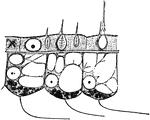
Body-wall
"Portion of the body-wall of Hydra, showing ectoderm cells above, separated by "structureless lamelia"…
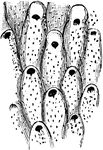
Prehistoric Bryozoan
Eschara elegans (Coscinopleura) is a prehistoric bryozoan, a marine animal similar to a coral.

Prehistoric Bryozoan
Eschara philomela is a prehistoric bryozoan, a marine animal similar to a coral.
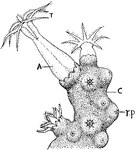
C. Ruburm
"Corallium rubrum, a corner of a colony. A., Anthocodia or retractile portion of a polyp; r.p., completely…
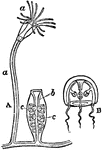
Campanularia
"Diagram of a colony of Campanularia, showing four forms of persons. A, portion of a fixed colony; a,…

Carmarina
"Diagram of a vertical section of Carmarina hastata, passing on the right through the whole length of…

Caryophyllia Cyathus (Lamarck)
"This genus has the summit hollowed out into a starlike cup. It inhabits the Mediterranean, and is common…
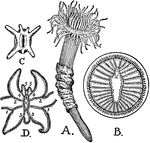
Cerianthus Solitarius
"A, Cerianthus solitarius. B, Transverse section of the stomodaeum, showing the sulculus, sl, and the…

Cladocora
"Transverse section through a zooid of Cladocora. The corallum shaded with dots, the mesogloca represented…
Clava
"Diagram of Clava, showing a hydriform person surrounded by a verticil of degenerate medusiform persons…
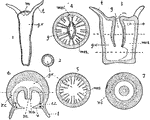
Cnidaria
"Sections of types Coelenterates (diagrammatic): 1 (longitudinal) and 2 (transverse) of a tubular hydroid;…

Coral
"Coral is the name applied to the stony structures secreted by many of the actinozoa, and applied to…
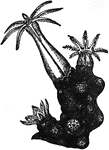
Coral
"Coral is the name applied to the stony structures secreted by many of the actinozoa, and applied to…
